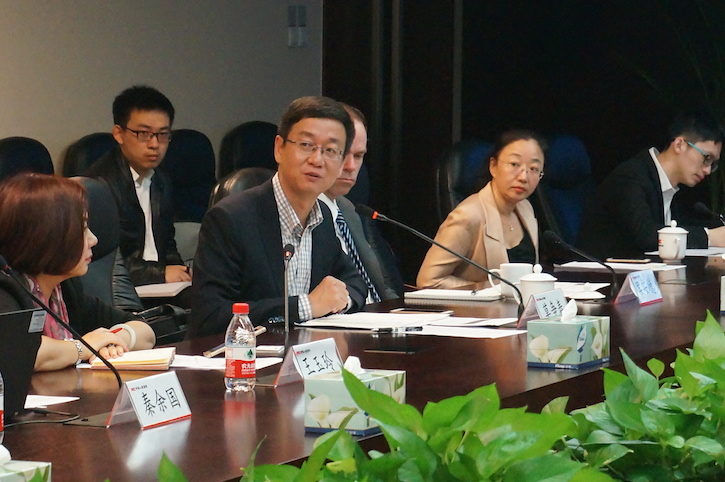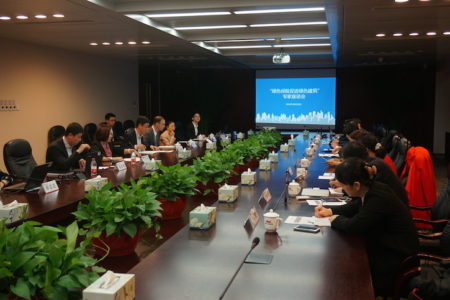
On October 18, the Paulson Institute co-hosted “Green Building Credit Enhancement Workshop” with the People’s Insurance Company of China (PICC). Experts and officials hailing from the Technology Development Center of the Ministry of Housing and Urban-Rural Development, Insurance Society of China, Green Finance Committee of China Society for Banking and Finance, Tsinghua University’s School of Architecture, Chinese Society for Urban Studies, and Shenzhen Institute of Building Research discussed how to leverage innovative insurance products to provide credit enhancement and risk management mechanisms for scaling up green buildings in China.
China has attached great importance to green buildings as a key initiative of the construction industry to pursue “green development” – one of the five development concepts outlined in the 13th Five-Year Plan. On January 1, 2013, the State Council issued a circular for distribution on the Action Plan for Green Buildings, officially establishing the development concept and short-term goals. On August 30, 2016, President Xi Jinping chaired the twenty-seventh meeting of the Central Leading Group for Deepening Overall Reform, at which the Guidelines for Establishing the Green Financial System were adopted. On the next day, seven state ministries, including the People’s Bank of China and the Ministry of Finance, jointly issued the Guidelines, clearly stating that green finance should provide financial services for project investment and financing, project operation, and risk management in the field of green buildings and energy-efficient buildings. Meanwhile, it is required that green insurance, as part of the green financial system, actively support the country’s green development and transition.
“The State Council has very high expectations for the development of eco-civilization and the green economy. However, due to various reasons, there is still a lot of real work to be done in our green building practices. In particular, there is a considerable gap to the goals set in the Action Plan for Green Buildings by the State Council in 2013. We have a long way to go to achieve the goals for the development of green buildings. This is also the context in which we carry out our research and study on this topic”, Ms. Wang Yuling, General Manager of Liability Insurance Division of the PICC said.

Dr. Kevin Mo, Managing Director of the Paulson Institute Representative Office in Beijing, said that “in recent years, China has leveraged administrative means and financial subsidies rather than market mechanisms to promote green buildings and energy-efficient buildings. If insurance as a risk management tool can be effectively applied to green buildings, it will make a real difference in scaling up green buildings.” In Financing Energy-Efficient Buildings in Chinese Cities, published in June, the Paulson Institute first proposed the idea of introducing a green insurance credit enhancement mechanism and leveraging market forces for scaling up green buildings.
Ms. Cai Yu, Deputy Secretary-General of Insurance Society of China and Vice Chairman of the Green Finance Committee, also believes that the insurance industry is well-positioned to accelerate the development of green buildings in China, given the industry’s strong innovation capabilities and cross-sector influence. She said that “the insurance industry will have a big role to play in promoting the development of green industries and participating in environmental risk management; also, insurance as a risk management tool will have considerable potential in the field of risk management in the future. Of course, this requires us to do creative work and to operate insurance business as a risk management tool in an innovative way”. Meanwhile, she also said she believed the workshop would help catalyze and demonstrate the effect green insurance innovation can have on green building development.
Mr. Qin Yuguo, Director of Industrial Business of Liability Insurance Division of the PICC, talked about the ideas and technical problems to be solved in the development of liability insurance products for green buildings. He said that “after research, we found the following problems in the promotion of green buildings: First of all, there is an urgent need to establish a scientific, standardized and objective third-party evaluation system. Secondly, there is a lack of effective incentive mechanisms. In fact, the policy of subsidies for green buildings has not been carried out, although it was clearly stipulated in Circular No. 167 jointly issued by the Ministry of Finance and the Ministry of Housing and Urban-Rural Development in 2012. Thirdly, the incremental costs of scaling up green buildings are high. According to a recent study, the costs of green buildings increase by 2.7% -9% on average. Although mandatory compliance with green-building standards is required for some buildings, it has not been strictly enforced. As a result, there are many obstacles in scaling up green buildings”.
Based on the insurance-based credit enhancement mechanism for green buildings proposed by the Paulson Institute paper, the PICC has done the conceptual design for green insurance products. Mr. Qin also pointed out that there are some key technical issues to be addressed and areas worthy of discussion in the process of refining insurance schemes. He hoped that the workshop and follow-up activities would help to fulfill the design of the innovative green insurance products, and would play an active role in the early introduction of green insurance into the construction industry and in the effective promotion of the healthy development of green buildings on a large scale.
During the workshop, the officials and experts shared their views and perspectives, reached a consensus on the resolution of some technical difficulties, and expressed the desire to further communicate and exchange ideas on the unresolved problems. With the active participation and cooperation of all the participants, the workshop was very productive. The success of this workshop not only presents an optimistic outlook for cross-sector cooperation between the insurance and the construction industries, but also provides a good opportunity for the insurance industry to develop more green insurance practices.





